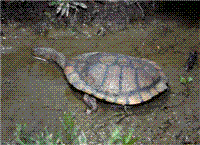Family
Chelidae (tortoises)
Genus
Chelodina
Species
longicollis
Threats/Control Methods - Regional
The biggest threats to Common Long-necked Tortoises in this region are predation of eggs and young by introduced species including foxes and feral cats. Drought periods can also be a problem for the species, as water bodies can dry out for extended periods.
Threats/Control Methods - Local
Common Long-necked Tortoises are often run over crossing roads in the urban area
Local/Urban Actions
In the urban area, residents can assist tortoises when seen crossing roads, although it is important to be careful, as they have very sharp claws.
Common name/s
Common Long-necked Tortoise, Eastern Snake-necked Tortoise, Eastern Snake-necked Turtle.
Distinguishing Features
The upper shell is dark brown to black, with whitish lines between the plates that make up the shell. The underside is yellowish, with black edges on the individual plates. The shell can grow to 25cm and when the head and neck are extended they can reach a further 20 cm.
Similar Species
In the ACT, there are no other naturally occurring tortoises.
Distribution
It is the only tortoise to occur naturally in the ACT. The Common Long-necked Tortoise is widespread in ACT waterways up to around 1000m, including slow-moving rivers, creeks, dams and urban lakes.
Country of Origin
Australia
Survey Techniques
Visual searches are most commonly used to identify tortoises, with experienced herpetologists being able to identify tortoises when they come to the surface to breathe.
Conservation (Pet/Pest) Status - National
The Long-necked Tortoise is not listed in a threatened category under the EPBC Act 1999.
Conservation (Pet/Pest) Status - Regional
The species is fairly common in the ACT, and as such is not regarded as a threatened species, and may be kept by people with no prior experience with keeping reptiles. No reptiles may be taken from the wild in the ACT without a licence however (see Reptile Policy).
LSCCES Population
Because many water features (for example lakes) in the ACT are kept full of water even in drought times, the species may survive better in urban areas than the surrounding countryside, where water bodies are more ephemeral.
Associated vegetation community
Water bodies and riparian vegetation. The Common Long-necked Tortoise is able to inhabit areas of varying water quality, including highly polluted urban waterways.
Limiting Resources
The availability of adequate water bodies and suitable prey within these may limit numbers of Common Long-necked Tortoises within the urban area.
Breeding
The female tortoise digs a burrow in which she lays her eggs in late spring to summer, with up to 25 eggs laid in each clutch. The eggs hatch in autumn. Hatchlings are very vulnerable to predators, with initially only a soft shell.
Behaviour
Tortoises can spend long periods submerged, although they come to the surface to breathe eventually. During winter, they become dormant, but usually remain in the water for this period.
Functional Group
Carnivore.
Food Species
The Common Long-necked Tortoise preys on a wide variety of invertebrates and vertebrates, including snails, small fishes, tadpoles and frogs. Sometimes the tortoise will also feed on carrion.
Predators
The fox predates on the species, as they eat juveniles of the species, as well as the tortoise's eggs.
Interesting Fact
The family chelidae includes freshwater turtles which are aquatic or semi-aquatic. In Australia, this group is known as tortoises, although strictly they are turtles. This naming is used instead to distinguish these reptiles from the large marine turtles that inhabit the seas surrounding Australia.
References - (reader suitability of references, P=Primary teachers, S=Secondary students, T=Tertiary students and researchers)
Books:
Bennett, R. 1997. Reptiles & frogs of the Australian Capital Territory. National Parks Association of the ACT, Woden. S, T
Cogger, H.G. 1996. Reptiles and Amphibians of Australia. Reed Books Australia, Melbourne. S, T
Lintermans, M. and Osborne, W. 2002. Wet & Wild: A Field Guide to the Freshwater Animals of the Southern Tablelands and High Country of the ACT and NSW. Environment ACT, Canberra. S, T
Researcher: Ian Rayner

 Top
Top Top
Top